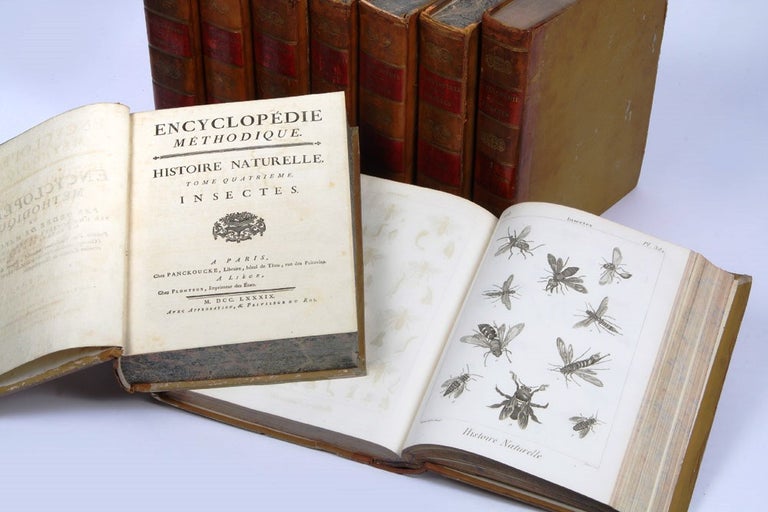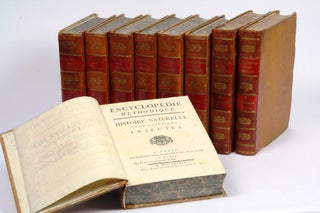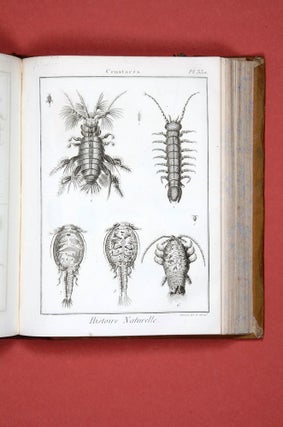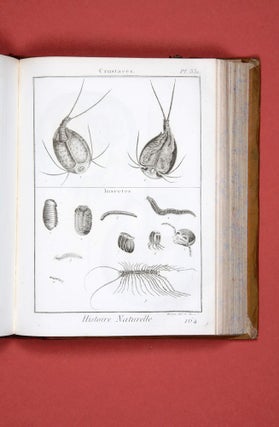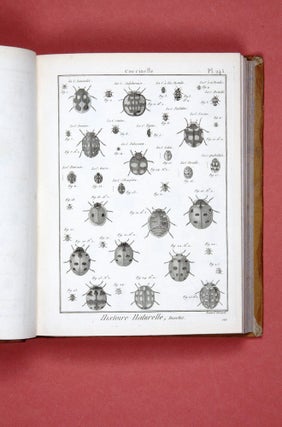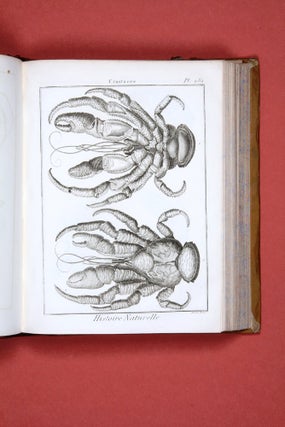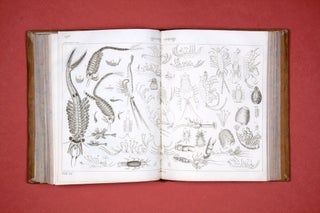Encyclopédie méthodique. Histoire naturelle: Insectes.
Paris: Panckoucke, Agasse, 1789-1825.
Nine quarto volumes, comprising seven text volumes and two volumes containing 397 engraved illustrations; in contemporary quarter roan with red labels.
Australian insects collected by Banks and Labillardière
The first major comparative study to illustrate Australian insects. Published over a span of almost two decades, this is an important work of entomology. A product of the high enlightenment, the Insectes was originally included within the famous Encyclopédie méthodique and the breadth of the manifest learning is phenomenal, a testament to the spirit of the enlightenment.
The first major comparative study to illustrate Australian insects. Published over a span of almost two decades, this is an important work of entomology. A product of the high enlightenment, the Insectes was originally included within the famous Encyclopédie méthodique and the breadth of the manifest learning is phenomenal, a testament to the spirit of the enlightenment.
Although the entomological works of John Lewin and Edward Donovan (both published 1805) have rightly been accorded iconic status in Australian natural history, this work by Olivier has not been given much attention despite the fact that the first four volumes date from the last decade of the eighteenth century. Scores of Australian insects are illustrated here for the first time – by our count at least 98 are firmly attributed to Australia or Van Diemens Land – most of them by comparison with the originals in the collection of Sir Joseph Banks. A selection of New Zealand bugs and others from Pacific islands also derives from the Banks collection.
Olivier built on the work of the scholars of his day, and was particularly reliant on the work of his contemporary Johann C. Fabricius, who printed the earliest textual description of any insects collected on the Endeavour voyage in 1775. Olivier's brief but gracious advertisement in the first volume here suggests that the primary resources for this work were the collections of Linnaeus, the descriptions of Fabricius, and the entomological riches of London. First among equals in London, Olivier notes, is of course Banks, who personally made valuable collections during his voyages around the world with Captain Cook ("La riche collection d'insectes que ce célèbre naturaliste à rapportés de ses voyages autour du globe, avec le Capitaine Cook…"). Not only did Banks himself collect on the voyage, but his interest in insects made Soho Square the paramount collection in London over the succeeding decades, as his friends and colleagues vied for the chance to supply non-descript insects; this is neatly shown by the fact that of the bugs from all parts of the globe, literally hundreds are described from specimens in the Banks collection. Olivier is known to have visited London in 1789, when he visited Banks, but also got in touch with other English collectors including the President of the Linnean Society James Edward Smith, the nurseryman from Hammersmith James Lee, John Latham and Thomas Martyn.
Equally significantly, by the publication of the fifth volume (first issued in 1807) many of the new insects being added, including several more Australian specimens, are from the Labillardière collection, and must have been gathered by the famous French natural historian on the d'Entrecasteaux voyage.
This work was the magnum opus of the French physician and keen entomologist Guillaume Olivier (1756-1814). Olivier personally collected widely in Europe and Asia Minor, famously embarking on a six-year expedition to Persia, returning to France in 1798. In 1800 he was appointed a Professor of Zoology at the Veterinary School at Alfort. He was a close friend of Fabricius as well as a patron and protector of another entomologist, Pierre André Latreille, at the close of the Napoleonic era. Olivier's own collection is now chiefly at the Muséum national d'histoire naturelle in Paris.
Entitlement to print and sell the Encyclopédie méthodique fell to several different publishers, not surprising given the scale of the work and its extended timeframe. The Insectes was earlier published in Paris by Baudoin, Lanneua & Desray between 1789 and 1808 under the sectional title Entomologie ou histoire naturelle des insects. In this set the first four volumes were published by Panckoucke between 1789-1792, the remainder by Agasse and his widow from 1811 to 1818.
B.M. (Nat. Hist.) II, 527.
Condition Report: A good set overall; some bindings a little worn, a couple of spines and joints shaken.
Price (AUD): $8,850.00
US$5,712.68 Other currencies


